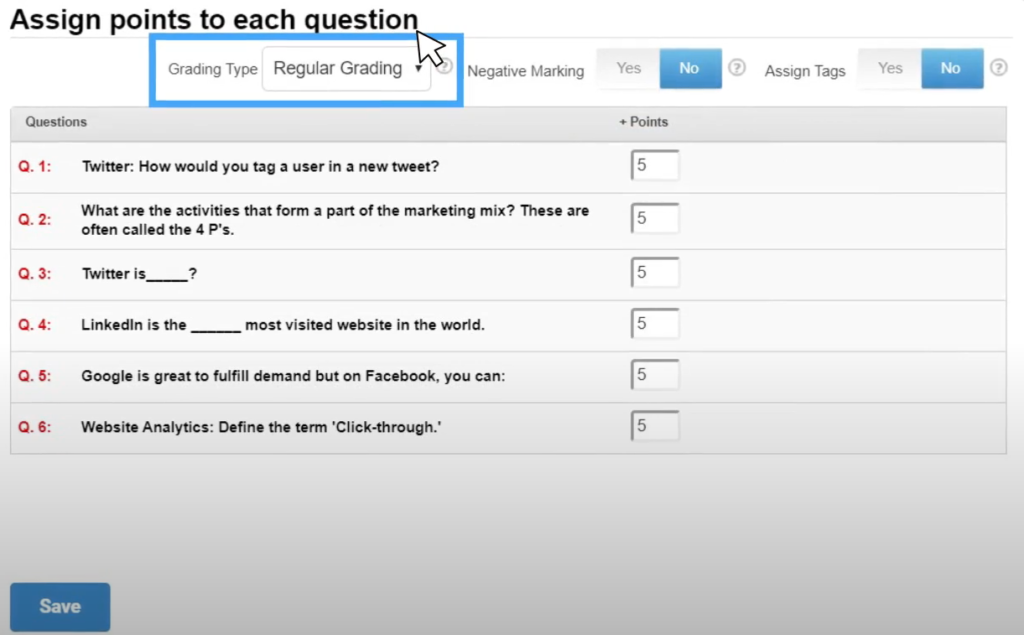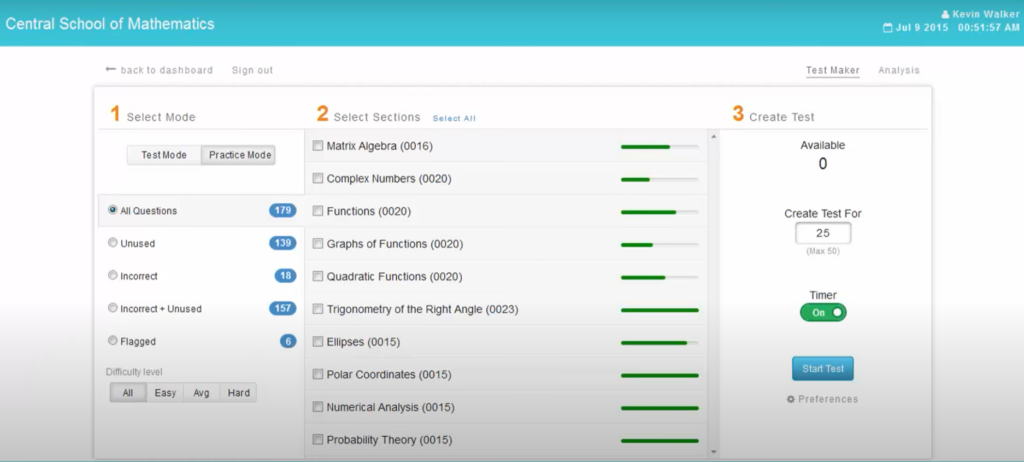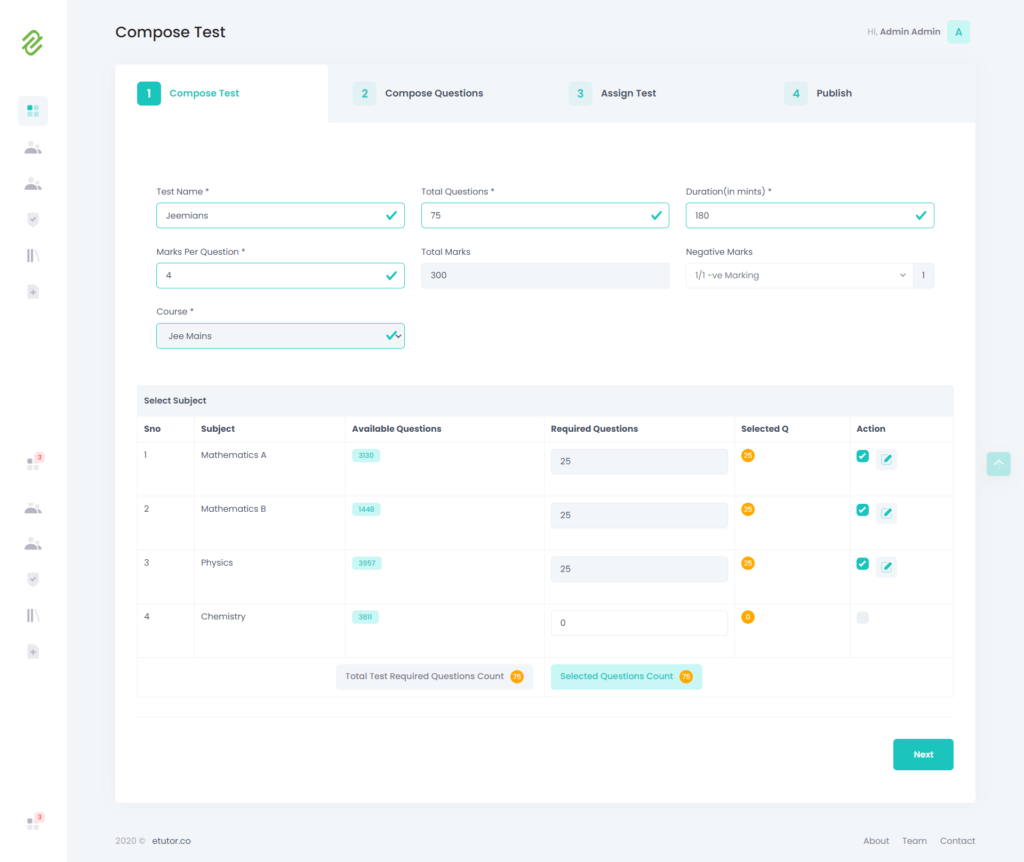Setting an exam paper doesn’t have to be stressful. A planned and detailed approach simplifies the task and enhances the quality of the exam. Let’s find out how to set an exam paper that aligns with the objectives and purpose of the test.
Exams are stressful for everyone. If parents and students focus on the writing part, teachers are responsible for setting the ‘right’ exam paper. Various elements come into play at this stage. Setting the exam paper is a strenuous and time-consuming task for teachers. They have to be thorough and ensure that the exam paper aligns with the purpose/ reason for testing the students.
Luckily, advancements in technology and EdTech tools help teachers set the exam paper in less time. Artificial intelligence-based tools assist teachers in creating the exam paper and customizing it within minutes.
But what makes a good exam paper? How to create an exam paper that helps assess the skills and knowledge of the students? Let’s read and find out.
How Do You Write a Good Question Paper?
Before we go into detail about how to make a test paper, we’ll first understand the attributes of a good question paper. The results of an exam depends on the test paper as well as the students’ abilities.

Clarity
Are the questions readable? The results of the test should not change based on who the tester or scorer is but based on who takes the exam. How you prepare question paper online should align with the purpose/ outcome.
Understandability
How easy or difficult are the questions to understand? A student can provide an answer only when they understand what the question means. The questions need to be specific and not vague.
Relevance
The question might have been taken from the syllabus but is it relevant in the overall context of the exam? Does it test the students’ memory, skills, or knowledge?
Objectivity and Scope
An exam paper needs to be objective and free of personal bias. The questions should not target or attack a group, community, culture, or ethnicity. Similarly, the scope of the questions needs to be defined so that the student knows how much to answer.
Purpose or Intent
What is the purpose of the exam? Do you want to test the student’s memory? Do you want to test their ability to work things on their own? Start by defining the purpose of the exam when considering how to make question paper online.
Thought Stimulation
The questions have to stimulate and make students think. They shouldn’t lead the student to assume or be biased but should nudge them to consider all alternatives and write their opinions.
Limiting the Focus
An exam paper has multiple questions to cover the vast syllabus and test the students’ abilities in different ways. It’s important to not overuse a question and make it multi-dimensional. Let a question focus on one aspect while another question deals with a different aspect.
Types of Questions in an Exam Paper
It’s up to the teachers to decide the type of questions you want to include in the test paper. Should the exam paper include objective questions, or should it be descriptive? Maybe a combination of both would be beneficial for a balanced assessment.
Let’s look at the different types of questions used in exam papers. You can rely on test generators to choose the types of questions and create the exam paper.
Multiple Choice
MCQ is a question with three to four choices, where only one of them is the correct answer. These questions can be quickly answered but can also be a little confusing, based on the difficulty level. Rephrase sentences from the textbook and structure them clearly to avoid being vague. Some AI-based question generator tools allow you to create MCQs and assign scores for correct answers in advance. It also allows you to provide instant feedback to students with reference links for them to learn and understand.

True or False
A compound statement is made, and the student has to determine if it is correct or incorrect. This question can only have two answers. Students can guess the answer and have a 50% probability of getting it right. Don’t make the sentences too complex. Double negatives can be misleading. Keep the statements uni-dimensional and stick to one theme.
Fill Ups
Filling the blanks can also be termed a short answer type of question. These questions have only one correct answer and are easy to complete in less time. A single question can have more than one blank, though it is recommended to not add beyond four blanks. Don’t take out too many words as it makes the question vague and difficult to understand. You can include a prompt at the end of the question by providing two or three options to choose the best fit.
Matching
Matching questions are easy enough to answer though they can be a little time-consuming compared to the previous two types of questions. The questions should be short and to the point. Provide clear instructions about how to match the columns. Don’t ask more than five or ten matching questions. They should all fit on one side of the paper.
Essay or Descriptive
Descriptive questions require moderate to long answers for a question. These questions take the most time and test the memory, comprehension abilities, and knowledge of the students. Students have to think, analyze, and answer the question. Make the intent clear by using words such as compare, contrast, describe, explain, etc. Word the question as clearly as possible. Suggest the number of words or lines you want the answer to be. Descriptive questions can be complex or simple.
The exams can be conducted online or offline. You can create the test paper using the tools and print the questions for an offline exam. A few edtech platforms allow you to create the test paper and conduct the exam online. You can track each student’s details (device information, IP address, time taken for the exam, location, questions left unanswered, etc.) to maintain a proper record of the test.

How to Set a Good Exam Paper?
Setting a good exam paper requires effort and understanding. Teachers have to consider a range of aspects such as the need for the test, the source, the duration, and the scoring system to ensure there is no bias, discrimination, or prejudice. Students should have equal opportunities to attempt the exam and prove their abilities.

1. Determine the Need for the Test
It is always crucial to establish the ground rules first. What do you wish to achieve by conducting the exam? Make a list of aspects you want to assess. This list will help in creating the exam paper. The questions should align with what has been taught in the class and what you wish to assess. There should be no gap between the knowledge imparted and the knowledge being tested.
2. Choose the Types of Questions
The types of questions depend on your exam objectives. For example, MCQs cannot be used if you want to test the students’ abilities to explain their ideas in words or analyze a topic and share their ideas. Descriptive questions work best to get an insight into the student’s thought process. Similarly, true or false questions can be used to assess if the students have a clear idea about a topic and can differentiate between right and wrong. However, true or false questions are also based on guesswork since they give 50% accurate results and should be used sparingly.
3. Use Authentic and Validated References
When you create a question paper from text, make sure to use authentic references which have already been shared with the students. Textbooks by another publisher cannot be used to create an exam paper when the students have been taught from different source material.
PrepAI is an AI-based question generator platform that accepts four types of input content:
- Copy-paste text from the digital source material
- Enter the topic name and search online through the tool
- Upload video file or video URL
- Upload PDF/ Docx files from the computer

4. Rely on the Question Generation Platform
Whether you want to conduct a surprise test or a full-fledged exam, using technology can save time, energy, and resources. There are various question generator platforms in the market that help you create an exam paper in just a few minutes. Moreover, you retain control over the process and can make the necessary changes to the question paper before finalizing it.
PrepAI uses artificial intelligence and natural language processing to read the input material and create a question paper based on your requirements. It is a comprehensive tool that allows you to include different types of questions, choose the difficulty level, and edit the questions to match your exam objectives. It greatly simplifies how you set question paper and conduct the exam.

5. Edit and Finalize the Exam Paper
It’s crucial to edit the exam paper before you finalize it. Get the test paper assessed by another teacher to confirm that it is clear, concise, and free of bias. It doesn’t matter if you used the traditional method or relied on technology to set the paper. A round or two of editing is a must to ensure there are no errors. Most question generator tools allow you to edit the questions automatically created for the input text.
6. Provide Clear Instructions
Mention the instructions at the top of the exam paper. Be clear, precise, and specific. List the dos and don’ts in neat order and explain what you expect from the students taking the exam. Write the instructions in short and simple sentences. Avoid complex terminology.
7. Set the Exam Duration
You need to set the duration for the exam after finalizing the paper. Determine the number of questions, their complexity, and the time taken to answer the short and long questions. Though exams test the students’ ability to perform in a limited time, remember that it also creates pressure that leads to mistakes and stress attacks. An effective way to set the exam duration is by taking the test yourself along with another teacher.

8. Develop the Scoring System
How do you plan to assess the exam papers? Have you allotted marks for each question? Do the marks match the question in terms of ease of answering, duration, and length? Each question can have a different score to further detail the exam paper.
For example, an MCQ in a Mathematics exam might require the student to solve the question before choosing the correct answer. This requires more time and can have a higher score. Descriptive questions are marked higher than objective questions.
9. Conduct the Exam
The last step is to conduct the exam either online or offline as per the guidelines of the educational institution. You can use the same exam software to automate assessments if the feature is provided by the platform.
For example, if you created the exam paper using PrepAI, you can share the test link with students via email and provide instructions for them to submit the answers online. The platform will automatically grade the answers and share results with the participants. Teachers can access the submission, results, and analytics through the account dashboard anytime they want. Additionally, they can download the question paper (with or without the answer key) and conduct the exam offline in the classrooms. In this instance, the answer sheets have to be manually assessed by the teachers.
How to Set the Right Difficulty Level: Tips for Fair and Accurate Exams
Now that you know how to make online question papers for students, it’s time to consider the factors that ensure the exam paper has the right difficulty level and can give accurate assessments of the students. After all, an exam paper that is too easy can result in higher marks for everyone, while a question paper with too many hard topics can lead to fewer marks. Finding the right balance is necessary to assess students’ knowledge and performance.
Consider the following question paper setting guidelines to conduct fair and accurate examinations.
Based on Syllabus
The exams, be it class tests, term or final exams, are conducted to evaluate if the students have gained the required knowledge. This is the syllabus decided for the educational year, and the outcome expected is for the students to learn (memorize and use) the content curated for the syllabus. Even competitive exams have a defined syllabus that the participants must consider when preparing. Cover all the important topics of the syllabus in the test paper. However, make sure that not even a single question is beyond what has been taught to the students. You can determine the important topics by analyzing previous question papers.
Combination of Question Types
How to make a test paper for students that is neither complex nor easy? Use more than one type of question and distribute the marks accordingly. For example, you can ask fewer short answer questions and long answer questions to test your in-depth knowledge. Then, you can create an objective section with multiple choice, fill-in-the-blanks, matching, jumbled sentences, or true/ false that can be completed in less time and add to the final marks. That way, teachers can test the lower-order and higher-order thinking skills of students. This also ensures that the question paper is of the difficulty level and gives everyone a chance to prove their abilities.
Time Limit/ Duration
Exams don’t last for countless hours, right? Every exam has a specific duration. Students are not given extra time to answer the questions. So, when you set an exam question paper, you should consider whether or not it can be answered within the given time limit. For example, long answer questions require more time as students have to provide clear and detailed answers. MCQs with mathematical equations may require calculations and take longer than grammatical or theoretical questions. Ensure that the students have enough time to work on these details. Finally, consider a few extra minutes for them to double-check the answers. The best way to be sure that the exam paper aligns with the duration is to take the test yourself or ask other teachers or volunteers to attempt the test paper. Use this feedback to make the necessary changes.
Negative Marking
Negative marking is one way to make a test more difficult but it needs to be used with care. National-level competitive exams tend to use negative markings since it helps eliminate a greater percentage of applicants. That way, only those who have worked hard for the exam are likely to be shortlisted or cross the cut-off marks. However, using negative marks for subjective exams in schools is not recommended. Here, the focus is on determining if the students gained the required knowledge. If all students clear the exam, all of them can be promoted to the next level. Moreover, negative marks are easier to allot for objective questions like MCQs, true/ false, fillups, matching, etc.
Eliminate Bias and Discrimination
This is the most important element to keep in mind when creating a question paper online. Personal bias and opinions have no place in an examination. Be it the topics, questions, or assessment methods, don’t let your feelings come in the way of being rational. Don’t use discriminatory language in the question paper. Sensitive topics like religion, culture, ethnicity, race, etc., should be handled carefully by sticking to facts. There’s no place for unproven theories or personal ideologies. The same applies when correcting the answer sheets. To avoid such bias and discrimination, use an AI-powered question generator tool to create the test paper. However, ensure the input content you provide the tool is from valid and authentic sources and doesn’t discriminate against anyone.
Final Words
Take time to set the exam paper and use student feedback to make changes if necessary. The exam should give you a comprehensive picture of the student’s abilities and identify the areas for improvement.
Make use of the latest technology and tools like PrepAI to simplify the process and reduce stress. You can create better-quality question papers with minimum effort from your side. This gives you enough time to assess the test paper and ensure that it meets the requirements.

 Test Conducting feature is now live. You can now conduct tests from your generated question papers.
Test Conducting feature is now live. You can now conduct tests from your generated question papers.




